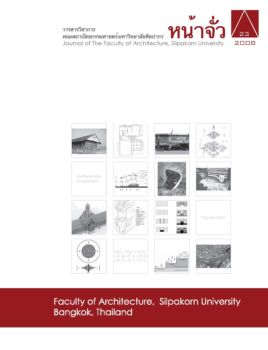การระบายอากาศร้อนใต้หลังคาสามารถลดความร้อนที่เข้าสู่อาคารได้จริงหรือ
Keywords:
การระบายอากาศที่ช่องใต้หลังคา, ลดความร้อน, attic ventilation, reducing heat gainAbstract
การออกแบบอาคารพักอาศัยในประเทศไทย นิยมออกแบบให้มีการระบายอากาศร้อนจากใต้หลังคา มาเป็นระยะเวลายาวนานมากตั้งแต่อดีต แต่จากการศึกษาโดยวัดค่าอุณหภูมิอากาศภายในและอุณหภูมิที่ผิวใต้ฝ้าเพดาน และอุณหภูมิใต้ช่องหลังคาเปรียบเทียบกันระหว่างอาคารพักอาศัยที่ใช้ฝ้าชายคาระบายอากาศและอาคารที่ใช้ฝ้าชายคาปิดทึบ พบว่า อุณหภูมิอากาศในช่องใต้หลังคาไม่มีความแตกต่างกัน เพราะในสภาพจริงช่องระบายอากาศซึ่งใช้มุ้งลวดกันแมลงมักมีฝุ่นและสิ่งสกปรกต่างๆ อุดตัน
เมื่อทดลองนำมุ้งลวดที่ช่องระบายอากาศออกให้อากาศสามารถผ่านได้สะดวกขึ้น พบว่า อุณหภูมิอากาศในช่องใต้หลังคาลดลง มีผลให้อุณหภูมิที่ผิวฝ้าเพดานในเวลากลางวันต่ำกว่าการใช้ฝ้าชายคาปิดทึบประมาณ 1oซ แต่อุณหภูมิอากาศภายในของทั้งสองห้องยังคงใกล้เคียงกัน และเมื่อเปรียบเทียบประสิทธิผลในการลดความร้อนที่เข้าสู่อาคารกรณีปรับอากาศระหว่างการใช้ฝ้าชายคาระบายอากาศร้อนกับการทำฝ้าปิดทึบและใช้อลูมิเนียมฟอยล์กันความร้อน ปูเอียงตามแนวจันทันโดยหันผิวเงาคว่ำลงสู่ช่องใต้หลังคา พบว่าการทำฝ้าชายคาปิดทึบร่วมกับการใช้อลูมิเนียมฟอยล์สามารถประหยัดพลังงานในการปรับอากาศได้มากกว่าประมาณ 49 % และยังมีค่าใช้จ่ายในการลงทุนใกล้เคียงกับการฝ้าไม้ระแนงเพื่อระบายอากาศร้อน
Can Attic Ventilation Reduce Heat Gained through Roof?
Pantuda Puthipiroj, Arch.D.
Assistant Professor, Faculty of Architecture, Silpakorn University
Most houses in Thailand are designed to ventilate hot air from attics. This has been practised from a long period of time. However, from the experiments comparing between the houses with vented and unvented attics, it was found that the attic air temperatures of both rooms are similar. This is due to the insect screens at the vented soffit were blocked with dust and dirt.
After removing the insect screens to allow more ventilation through the attic, it was shown that the ceiling surface temperature could be lower than that of the unvented attic about 1 oC, but the inside air temperatures of both rooms were
still similar.
The study also compared heat gain reduction between rooms with vented attic and unvented attic with aluminum foil facing shining side downward under air conditioning control. It was shown that the room with unvented attic consumed less
energy about 49 %. The investment cost of unvented soffit including aluminum foil was close to using wooden vented soffit.





